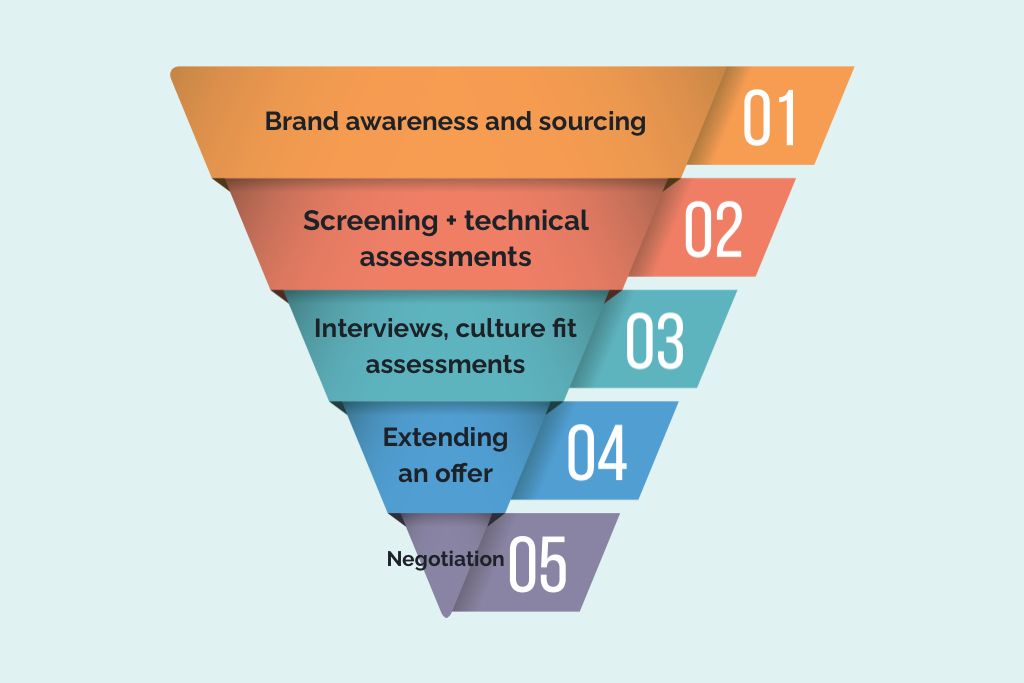4 Tips to Building an Engineering Team in 2022

With hiring rates through the roof, pay rising at its fastest rate in 20 years, and global VC deal funding at an all-time high, it can be an intimidating time to think about building an engineering team. But if you’re gearing up to break into the new year stronger than ever, there are still opportunities to find talent that can help your eng org keep innovating.
Any great eng team starts with careful hiring and cultivating the right talent. And while some might think hiring falls squarely under the HR umbrella, it’s ultimately your job as an engineering leader to hit the headcount plan and build teams that foster long-term growth.
In 2022, companies of all sizes are reconfiguring their recruitment and retention efforts; even behemoths like Apple aren’t immune to high employee turnover.
So at a time when IC engineers have more options than ever, how do you stand out among the pack? Here are four tips we think you need to know.
Tip #1: Know your hiring funnel inside and out
The first step toward building an engineering team is to understand your hiring funnel. The hiring funnel refers to the stages a potential candidate goes through before finally being onboarded.
A modern engineering hiring funnel might look something like this:
- Brand awareness and sourcing
- Screening + technical assessments
- Interviews, culture fit assessments
- Extending an offer
- Negotiation

Much like other aspects of an eng org’s development, analyzing (and subsequently tweaking) your hiring funnel requires the right metrics. Of course, every company’s hiring metrics will differ. Google’s hiring woes may come from candidates not accepting offers in the last step of the funnel, whereas smaller companies often struggle to attract engineers to fill key roles quickly enough.
This brings us to a useful starting point: conversion rates. Conversion rates answer questions about just how selective your company should be and help you get a grasp of why misalignment in the hiring process occurs. If there’s a massive drop-off after a certain stage, it’s time to reassess; if you’re left deciding between way too many finalists, you also need to pare down selections earlier on.
Back in 2017, an industry report from Lever analyzed over 600 companies with fewer than 200 employees, revealing that only 17% of candidates made it to the screening stage. Compare that to the sector-wide jobs surplus of today and it becomes clear that a static hiring funnel is one that stunts an org’s growth.
All of this is why a good hiring strategy takes stock of a company’s short- and long-term needs and includes considerations about the current market outlook for software engineers. It’s crucial to review your funnel monthly and keep track of things like the number of applicants, percentage of qualified candidates, and taking stock of how candidates heard about the position in the first place.
Tip #2: Build your engineering brand —and spread the word about it
Brand recognition pays dividends. From attracting talent through word of mouth to getting quality referrals, ensuring your company’s name gains traction is a tried and true hiring strategy.
Building a reputation that carries weight doesn’t happen overnight, and the first steps usually need to happen internally. In practice, that means clearly defining your eng teams’ identity and values to foster cohesion. After that, you can begin a more organic process of outreach —one that’s backed up by the real experience of ICs.
Start small. You don’t need to be on the front page of Hacker News to see a difference. Lean into your community and existing network to forge meaningful connections by participating in community talks and events. As such, you should also try to maintain an active presence on social media and engage with other eng leaders. Sometimes, all it takes is the right retweet to get your momentum going.
Your org should also publish content regularly via an on-site engineering blog. This is a great way to get the word out about new products, offer insight into your offerings, and simply cover topics of interest that potential hires might be searching about.
Producing relevant content doesn’t end there, however; it’s also key that you promote blog posts across channels like Twitter and LinkedIn. ICs and managers can share new posts on their personal profiles and get feedback from the broader community in real-time rather — that way, you won’t sit around waiting for page views to appear out of thin air.
Finally, if you’re looking for a way to further highlight internal talent in an engaging way, your org can host mini tech conferences and tell colleagues to invite friends.
For inspiration, here are some companies who have built up their brand successfully:
- In terms of large-scale orgs, few have a more comprehensive catalog of resources than Stripe. In addition to their blog, they also run the site IndieHackers, which is dedicated to interviews and knowledge sharing. And if all that wasn’t enough, Stripe has its own publishing house, too. While you may not have the resources to print books (yet), it’s worth taking note of their breadth and creative expansion.
- For digestible technical insights, check out Pinterest Engineering on Medium. Their work highlights how Pinterest has solved bugs and highlights individual projects like reducing iOS app size. Pinterest’s blog is published in both English and Spanish.
- And, of course, we’d be remiss not to mention CoderPad’s very own blog, featuring entries on technical interviewing, engineering leadership, and much more.
Tip #3: Expand your definition of ‘qualified candidate’
What does “qualified” really mean?
Today, it’s increasingly clear that most software engineers possess more skills than can be represented on a CV. And while attending the right academic institutions was once a prerequisite to landing a great position, there’s a growing understanding that talent comes from all different backgrounds. Your company’s hiring practices should reflect this.
CoderPad conducted a survey of nearly 14,000 developers, revealing that 40% of respondents didn’t learn to code at engineering school or university. On the recruiting side, we also found that the norms are shifting faster and faster each year. In the last twelve months alone, the percentage of recruiters hiring candidates from non-academic backgrounds has doubled.
If you’ve ever spent time browsing job descriptions, you’ve likely noticed some serious dissonance. Companies might require non-existent combinations of technical skill sets or 20 years of experience with React, ultimately leaving prospective engs scratching their heads.
In reality, there’s almost never a perfect fit. While you may not be ready to fully abandon the CV quite yet, your hiring should emphasize adjacent skills and look for candidates who have proven their ability to adapt and learn on-the-go. Particularly for mid- and senior-level positions, it’s key to seek out candidates with adjacent skills. Prospective employees can also gain insight about the types of tools they might need through your company’s public career ladder.
Finally, don’t forget the importance of upskilling when assessing a candidate’s profile. According to research from LinkedIn, the tech sector has the highest turnover rate of any industry today —prioritizing longevity, culture, and building skills is most often a better a more sustainable method than searching for candidates who tick every single box.
Tip #4: Hire globally, not just locally
The world of remote work is here to stay, sending ripple effects through hiring and recruiting. And even if some orgs return to a ‘hybrid team’ model, the last two years have laid the groundwork for a seismic shift that widens talent pools beyond traditional boundaries.
Gone are the days of the on-site interview and the traditional nine-to-five; further, our survey found that only 4% of developers want to be at the office full time. Though it’s certainly a new reality that takes some getting used to, both devs and eng leaders tasked with finding talent can benefit.
Not only can your talent search extend outside cities in which you have a physical office, it can cross borders. There are innovative software engineers around the world, as evidenced by continued VC investments in Latin America (where nearly $15 billion was raised in 2021) and on the African continent, which has seen startup investment through VC deals double since 2014.
Hiring outside the country you primarily operate in is easier than ever. Companies like Deel and Remote take on HR responsibilities and handle any regional compliance complexities so you don’t have to.
It’s a brave new world of hiring, but by fine-tuning your strategies for attracting talent and continually adapting you can take on 2022 with confidence.